: : Soy Sauce : :
After reading something like this, I’d rather stick to Kikkoman any day.
via Spoonfork (btw, Happy Gawai)
: : Soy Sauce : :
After reading something like this, I’d rather stick to Kikkoman any day.
via Spoonfork (btw, Happy Gawai)
: : Gawai : :
Went visiting last night to a collegue’s house. Had too much tuak @ rice wine as usual but it’s only once a year. Anyway, it’s always a fun time at her house with every one chit chatting until quite late and eating as well. With many cheers of ‘ahhhhhh-huuuuuuu!’ instead of Cheers. My collegue is a lovely hostess as well as her family. Some pictures of the food that was served.

A beautifully decorated cake showing a bag of rice and a traditional beaded choker. The details were just amazing. The cake was so attractive and eye-catching that no-one took a piece of it at all. As shown in the cake, it was courtesy of Hilton Hotel. Their bakery is seriously very good
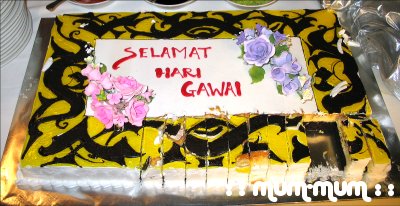
Another Gawai-themed cake, this time showing the intricate designs usually found on wood carvings.
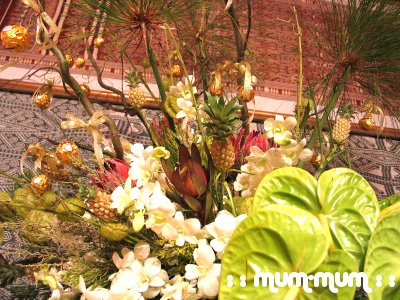
A lot of the children were looking at the golden-wrapped balls and suddenly realising that in the middle of a beautiful table arrangement, it was Ferrero Rocher dangling before their eyes! They also used small pineapple fruit as part of the decor as well as pitcher plants.
It was a nice night of meeting up with friends and their families whom I haven’t seen or mingled in a long while. I forgot how much fun it is just to sit down and make fun of each other.
Anyway, this is Gawai time. A time of good cheer, fun, laughter in the midst of all the tuak!
: : Potrait Illustration Maker : :

Cute no? Found the link from www.dymolove.com. Fun way to make a self-potrait.
: : Lemang ~ Iban Pulut : :
After travelling to the nearby mining town Bau to visit a friend, she gave me a piece of bamboo with lemang inside it. Lemang is glutinous rice cooked with santan @ coconut milk inside a piece of bamboo. Because of the length of the bamboo, it’s usually cooked under an open fire. Not that easy to do, it takes experience. Banana leaves are cut into strips and later rolled up to cover the entire inner surface of the bamboo, leaving the center part empty for the rice. The gluotinous rice is poured until it fills up about 1/2 of the bamboo. Later, a mixture of coconut milk and water is added in to cook the rice. Place over an open fire, the bamboo being supported at the top by a wooden frame.
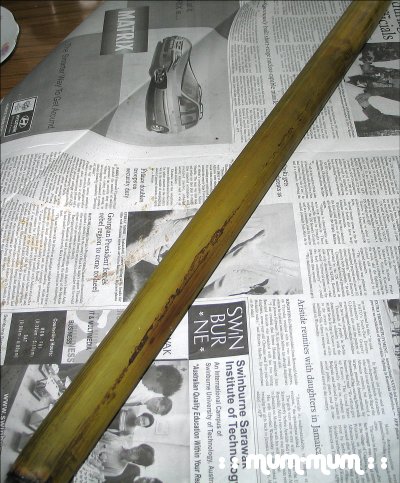
Here is the piece of bamboo filled with lemang. Note that it was already cooked by the time I brought it back home. Granny immediately wanted to try it out.
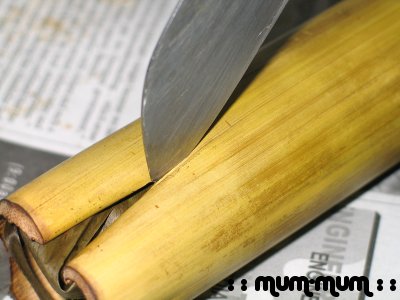
Using a knife, she started to make some slits along the length of the bamboo. Luckily, the bamboo used is a young one so it was easy to cut. Young bamboo aren’t as thick as the older ones which can be half a centimer thick! This one was half as thick. Make two slits so as to make it easier to pry the bamboo open.
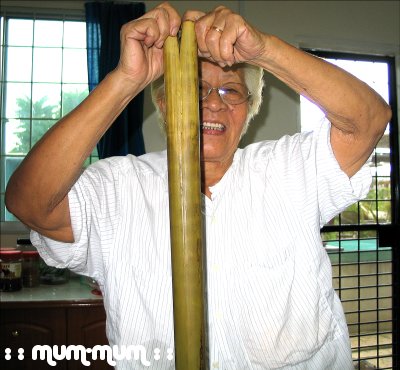
SuperGranny! Check out those abs!
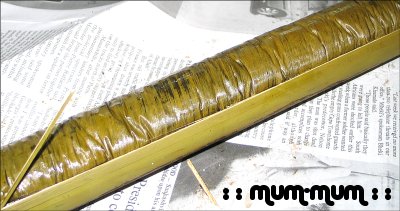
Tada! The exposed lemang. The green wrapping is the banana leaf.
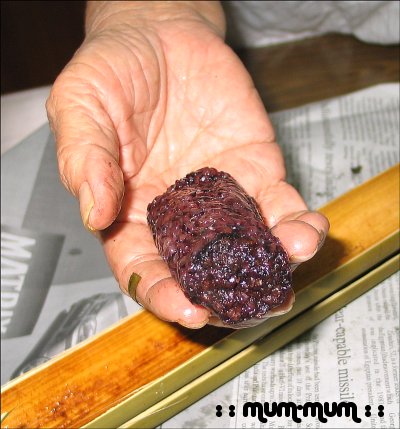
And, here is the lemang. It’s very red because it was made from the Iban Red Glutinous Rice. Tasted really nice. Goes extremely well with rendang or curry. Goes very well with satay as well.
: : Noodle Pie : :
Another great food blog but this time from Cambodia. Yum yum yummy. Attractive pictures with great writings. Unfortunately, couldn’t find a XML link. Darn. Can’t put it onto my Bloglines account now. Must tell my other uncle about this blog. He is currently working in Cambodia.
: : Malaysia’s Best : :

In the Star today, we received this great flyer from MoA and FAMA on 5 different kind of fruits grown in Malaysia. It’s amazing, I tell you. It provides a background on the fruits and also ripening indices in colour. Know what is the ironic bit? All 5 fruits which are known as local fruit are actually not originally from Malaysia but from other parts of the world.
All the pictures today are scanned from the flyer. I looked around for a softcopy of the flyer drifting around the net but couldn’t find out. Darn. So, decided to scan bits and pieces of it and provide a running commentary. The pictures are about selecting the fruit and how ripe it should be so that it tastes good.
Here is an introduction to the flyer :
“Malaysia’s Best” clearly communicates the promise of quality of each Malaysian fruit. For every farmer under the “Malaysia’s Best” programme has the necessary knowledge and experience in producing quality fruits, from selecting the best seedling to the harvesting period. All the latest in research findings and guidelines on more efficient farming methods like minimizing pesticide usage, for example are also passed on to these farmers on a regular basis to apply to their current or new crop. After which, every fruit picked and selected will go through a very strict and thorough inspection process prior to getting the “Malaysia’s Best” seal of approval.
So, let’s start with mangos :

I never did eat mango when I was a little girl. That’s because I was extremely fussy and never like trying out new kinds of food until I hit my teenage years. That’s when a whole new world opened up to me, including eating vegetables. Anyway, there is this huge mango tree in my neighbour’s house back in Miri. It is so big that eventually the branches spread over to our garden but we seldom eat it because a family of monkeys would get to them first. I also discovered that I like mangoes that are sour if they are cut into small pieces. It’s kind of like stage 4 in the picture above. Yum. Country of Origin : India.

Next on the list are papayas. Everyday, Granny would take some because it cures constipation. Seriously. This is a great natural remedy. Within 30 minutes of eating papaya, one has to rush to the toilet to “pass motion”. In Kuching, the sweet ones are usually the small round ones and that’s the one we usually eat. If you keep the seeds, dry them and plant them in the garden, they will grow easily. Country of Origin : tropical American, possibly southern Mexico.

A very prickly fruit but luckily not as prickly as durian. It’s great for digestion as well but over in Asia, we eat it with a dash of salt else our tongues will get so itchy, it’ll be extremely uncomfortable. Serious. Sometimes, we also eat it with thick and sweetened soy sauce. No, not the rojak sauce which has other herbs inside it. Just plain thick and sweet soy sauce. Yum. Country of Origin : Brazil, Paraquay.
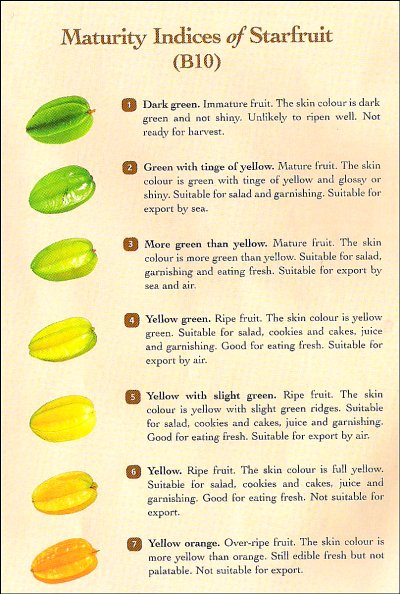
An amazing fruit that is rumoured to cure migraines and headaches. How true is that? Seriously, I’m not sure. Still, it’s a tangy fruit that is sweet. So far, I’ve never tasted a sour starfruit before. Great for salads and eating it fresh as well. Country of Origin : India, Ceylon and the Moluccas.

Heavy as anything. Yet, once it is cut opened, it is worth it. Some are sweet and some are not. There’s no true way to tell if it’s gonig to be very sweet from the outside. I suppose one can always go back to the seller and say that it wasn’t that sweet (in a teasing manner) and see whether you’ll be able to get the next one free or at least, at a discounted price. Amazing fruit. Country of Origin : Africa.
So, there you go. 5 fruits grown in Malaysia. I hope that the guide will be useful for everyone. It was for me.
Here’s a read on how using a squirrel to determine is a durian is ripe. It’s not the first time I’ve heard of it.
All the pictures were scanned from the flyer and the pictures were only edited to make the pictures brighter and smaller. The text remains the same. Am doing a small bit to promote fruits grown locally in Malaysia.